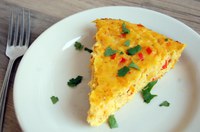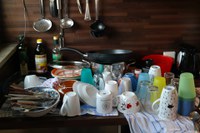Prairie Fare: Are You Inspired to Do Some Spring Cleaning?
(Click an image below to view a high-resolution image that can be downloaded)
By Julie Garden-Robinson, Food and Nutrition Specialist, NDSU Extension
As I looked around my office, the inspiration for this weekly column was right in front of me. Spring cleaning needs to be on my to-do list.
Fortunately, my office isn’t dusty, and the carpet was vacuumed recently. However, piles of paper accumulated on my desk and table during the winter, just like the deep piles of snow that I could see through my office window.
Unfortunately, my stacks of paper haven’t melted and disappeared.
I need to deal with the clutter and recycle some paper. I probably need to set a goal to deal with things digitally more often.
However, I can ignore things I can’t see, which isn’t always a good approach.
During this time of year, cleaning tends to be on people’s minds. We might drive around neighborhoods and see potential treasures on boulevards during spring clean-up week. Garage sales pop up as people clear their clutter after winter.
Raise your hand if cleaning your house is your favorite thing to do. Although cleaning may not be everyone’s favorite activity, cleaning has some real advantages.
Personally, I feel a strong sense of satisfaction when I clean a space. I always clear my desk and straighten my house before going to a conference or on a vacation. When I return to a fairly organized space, I’m inspired to unpack and catch up with everything I missed.
In fact, cleaning can be good for your health in several ways, according to researchers.
Having an uncluttered environment is good for your mental health, according to psychology researchers. Being surrounded by piles of stuff is stressful and can make concentrating on your real tasks more difficult.
Besides mental health benefits, cleaning also may help promote physical health. A research team from Indiana University noted that people with cleaner homes were healthier and more physically active.
Cleaning can burn calories. For example, a 150-pound person doing light housework burns about 90 calories in 30 minutes. Mopping for 30 minutes burns about 150 calories, which is about the same amount you burn during a 30-minute walk.
Cleaning also can reduce illness-causing bacteria, especially in your kitchen. Several types of illness-causing bacteria may be lurking on your kitchen surfaces.
Unfortunately, unlike stacks of paper and a layer of dust, you can’t see bacteria with your bare eyes. You can’t smell or taste the most dangerous types of bacteria, either.
According to the Fight BAC campaign (short for “bacteria”), disease-causing bacteria such as salmonella, Staphylococcus, E. coli and/or listeria may inhabit our kitchens. Bacteria may arrive on raw chicken, meat, eggs or other protein-rich foods.
Bacteria can be transferred around your kitchen on other foods, such as salads, and by hands, cutting boards or knives. Bacteria also might hitch a ride on a used washcloth, towel or sponge.
Keep these cleaning tips in mind all year. Learn more about the national Fight BAC campaign at https://www.fightbac.org.
- Wash surfaces, such as countertops and cutting boards, thoroughly with hot water and soap.
- Follow the washing step with a sanitizing step, which further reduces the presence of bacteria. You can use a commercial disinfecting spray or make your own sanitizing solution. Prepare a chlorine bleach solution consisting of 3/4 teaspoon of unscented chlorine bleach per quart of water or 1 tablespoon of bleach per gallon of water. Apply to the surface, and let the bleach-water solution stand on the surface for several minutes. Then rinse and air dry.
- Consider using paper towels to clean kitchen surfaces. If you use cloth towels, wash them in the hot cycle of your washing machine. Beware of kitchen sponges, which can harbor bacteria. If you like sponges, replace them often.
- Check out your refrigerator. Does it need cleaning? Experts recommend cleaning your refrigerator weekly to decrease germs that can contaminate foods. Clean the interior refrigerator surfaces with hot water and soap, rinse with a damp cloth and dry with a clean cloth. In this case, avoid using chlorine bleach, solvent cleaning solutions or abrasives because they could damage seals, gaskets and linings.
- Clean your kitchen sink, drain and disposal once or twice a week with warm water and soap. Disinfect the drain and disposal by pouring in a solution of 3/4 teaspoon chlorine bleach per quart of water.
- Inspect the inside of your microwave oven. Are there spills? Heat a microwave-safe bowl filled with water on high for about 4 minutes. Remove the bowl, and use the hot water and dish soap to wipe down the microwave interior. Dry with a fresh paper towel.
Here’s a recipe that might help you use up some ingredients in your cupboard or refrigerator. Lentils, which have a long shelf life, are good sources of both protein and fiber. Eggs, by the way, are good about three weeks beyond the date on the package if kept cold. See https://www.ag.ndsu.edu/food for more information about food safety and preparation.
Lentil and Veggie Cheddar Bake
1 c. red lentils
2 c. water
3/4 c. cheddar cheese
1/2 red bell pepper, finely chopped
1/2 green bell pepper, finely chopped
1 small onion, finely chopped
2 cloves of garlic, crushed
Black pepper and salt to season
4 eggs
Preheat oven to 350 F. Bring red lentils and water to a boil in a saucepan. Reduce heat to simmer. Cover and cook until water is almost absorbed, turn off heat, add lid and leave for 10 minutes to soak up any remaining liquid. In the meantime, spray a frying pan with spray oil and cook the onion, peppers and garlic for about 4 minutes. Once lentils are ready, add them to a bowl. Add the onion, red pepper, green pepper and garlic, then season with salt and pepper. Add the cheddar and eggs, and mix thoroughly. Spray an 8-inch round pan with cooking spray, add the mixture and bake in the oven until it is golden and set, about 30 to 40 minutes.
Makes eight servings. Each (1/8 slice) serving has 150 calories, 3.5 g fat, 13 g protein, 17 g carbohydrate, 4 g fiber and 135 mg sodium.
(Julie Garden-Robinson, Ph.D., R.D., L.R.D., is a North Dakota State University Extension food and nutrition specialist and professor in the Department of Health, Nutrition and Exercise Sciences. Follow her on Twitter @jgardenrobinson)
NDSU Agriculture Communication – May 2, 2019
| Source: | Julie Garden-Robinson, 701-231-7187, julie.garden-robinson@ndsu.edu |
|---|---|
| Editor: | Becky Koch, 701-231-7875, becky.koch@ndsu.edu |




